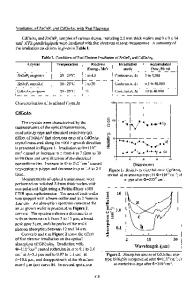Evidence of High Electron Mobility in CdGeAs 2 Single Crystals
- PDF / 382,015 Bytes
- 6 Pages / 418.68 x 637.2 pts Page_size
- 95 Downloads / 406 Views
ABSTRACT CdGeAs 2 single crystals were prepared by low temperature crystallization from a nonstoichiometric melt. The results of the first study of the temperature dependencies of the electrical conductivity and the Hall coefficient of n-type CdGeAs 2 single crystals prepared by this new technique are reported. All the as-grown crystals show n-type conductivity. These single crystals had free electron concentrations of (1 - 2) • 10 18 cm -3 and Hall mobilities of more than 10000 cm 2/ ( V s) at T=300 K. These room temperature electron mobility values are four times larger than previously reported. In the high temperature region (T> 150K), the temperature dependence of the Hall mobility exhibited a behavior characteristic of phonon scattering. Below 150 K, a deviation from this behavior indicated an increasing contribution of static lattice defects to scattering. The Hall mobility in these crystals was found to reach - 36000 cm 2/( V. s ) at 77 K. The first photosensitive n-type CdGeAs 2 /n-type InSe heterostructures were constructed by contact methods. Photosensitivities of 70-100 V/Wwere observed. This is substantially better than for previous structures using conventionally grown CdGeAs 2 and indicates the high quality of the crystals. It is concluded that the low temperature growth technique is promising for the preparation of more perfect CdGeAs 2 crystalsINRODUCTION It is possible to widely vary the fundamental properties of diamond-like ternary semiconductors by changing their atomic composition in accordance with the fundamental criteria for their formation developed by Professor N.A. Goryunova [1]. As a result, they can be tailored to meet the specific demands of a variety of electronic and optical applications. For instance, substitution of atoms fromGroups II and IV for two atoms of the Group III atom in a A B compound results in the formation of ternary compounds of the form A"BIvCV2, which are more numerous than the binary A"IBv compounds. While their physical properties make them suitable for conventional semiconductor electronic application, they also have the potential for providing new semiconductor applications beyond those that can be provided by elementary and binary semiconductors [2,3]. The most important differences ofAAB C 2 compounds from their Ai 'B analogs are the anisotropy in their physical properties, optical birefringence and very large nonlinear susceptibilities. Because of these properties, there is presently a revival of interest in these chalcopyrite semiconductors and in specifically, CdGeAs 2 [4-8]. CdGeAs2 was first synthesized and its fundamental properties studied at the A.F. loffe Physico-Technical Institute of the Russian Academy of Sciences [9-11]. The main limitation of CdGeAs2 in applications such as high-efficiency nonlinear optical converters is the fairly high optical absorption in its transmission range due to native defects [4,7]. It should be stressed that all studies performed until recently were made on single crystals prepared from close to stoichiometric melts a
Data Loading...










